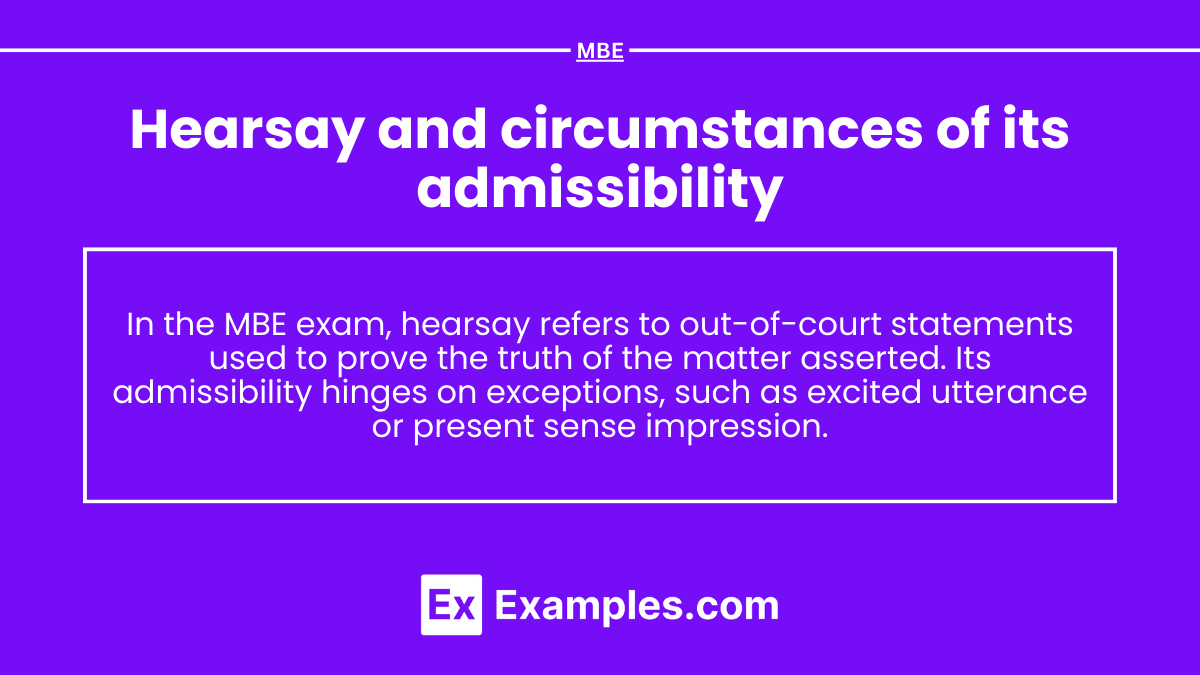In the MBE exam, understanding “Hearsay and Circumstances of Its Admissibility” is essential for identifying when out-of-court statements can be admitted. This topic covers the hearsay rule, its rationale, exceptions, and exclusions, helping you determine when hearsay evidence is admissible, a critical skill for analyzing MBE evidence questions effectively.
Learning Objective
Study “Hearsay and Circumstances of Its Admissibility” for the MBE by understanding what constitutes hearsay, its principles, and the conditions for admissibility. Examine key exceptions and exclusions, including present sense impressions, statements against interest, and excited utterances, that permit hearsay statements despite their general inadmissibility. Learn how reliability is established for each exception and analyze scenarios where hearsay affects trial outcomes. Apply this knowledge in practice questions to accurately identify when hearsay impacts legal decisions on the MBE.
Definition and Purpose of the Hearsay Rule
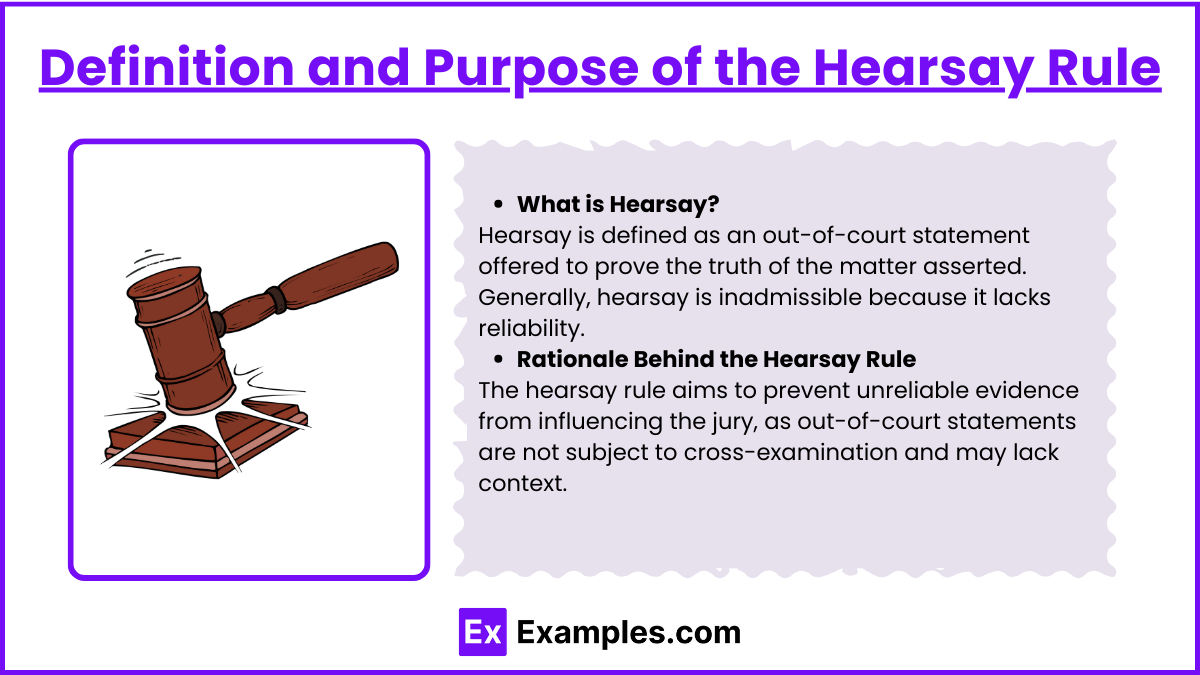
- What is Hearsay?
- Hearsay is defined as an out-of-court statement offered to prove the truth of the matter asserted. Generally, hearsay is inadmissible because it lacks reliability.
- Rationale Behind the Hearsay Rule
- The hearsay rule aims to prevent unreliable evidence from influencing the jury, as out-of-court statements are not subject to cross-examination and may lack context.
- Identifying Hearsay
- Statements made by someone other than the witness currently testifying, offered to prove the truth of their content, typically fall under hearsay and require careful analysis to determine admissibility.
Exceptions to the Hearsay Rule
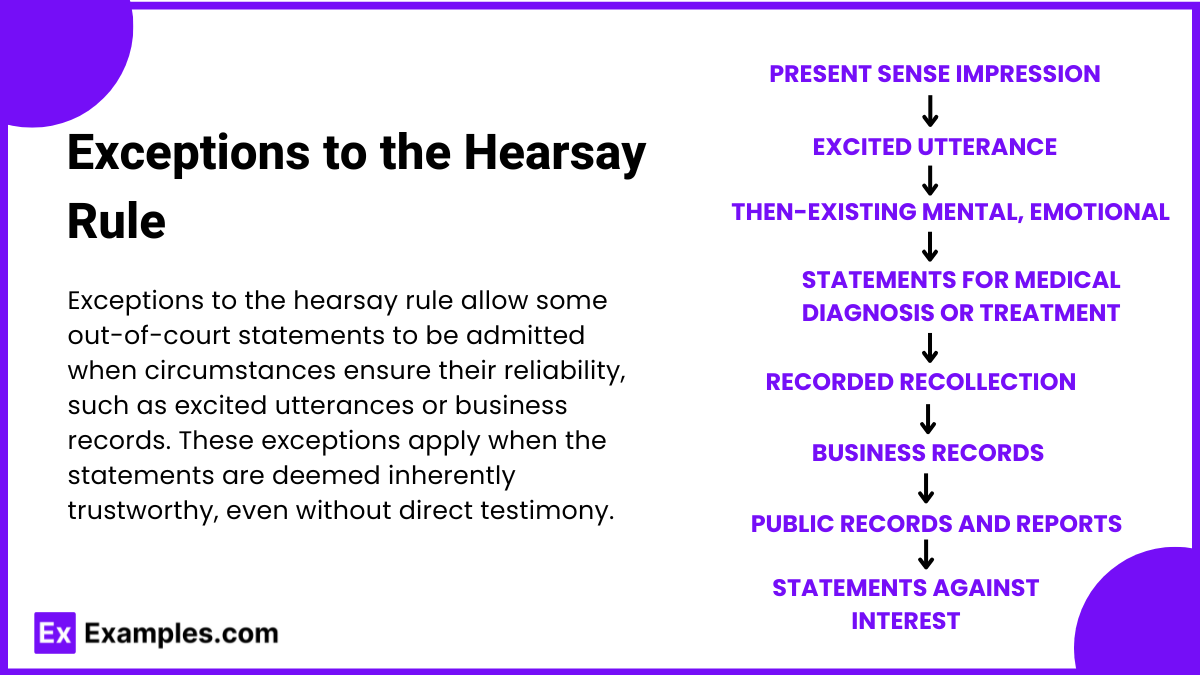
- Present Sense Impression
- A statement describing an event or condition made while the declarant was perceiving it, or immediately thereafter, can be admissible due to its reliability from timing.
- Excited Utterance
- Statements made in response to a startling event, while the declarant is still under stress, are considered reliable because the excitement limits fabrication.
- Then-Existing Mental, Emotional, or Physical Condition
- Statements describing the declarant’s then-existing state, such as emotion or intent, are admissible for showing condition rather than proving external facts.
- Statements for Medical Diagnosis or Treatment
- Statements made for medical purposes, describing symptoms or causes, are admissible because of the declarant’s motivation to be accurate for diagnosis.
- Recorded Recollection
- When a witness cannot fully recall events but previously documented them accurately, the record can be read into evidence if the witness verifies its accuracy.
- Business Records
- Records made as part of regular business activity, with a foundation showing regularity and accuracy, are admissible, provided they were created at or near the time of the event.
- Public Records and Reports
- Government records on activities, matters observed, or factual findings from investigations are admissible under certain conditions, such as reliability and public access.
- Statements Against Interest
- Statements made by an unavailable declarant that were against their own financial or penal interest at the time are admissible, as people are unlikely to make self-harming statements unless true.
Circumstances Excluding Certain Statements from Hearsay
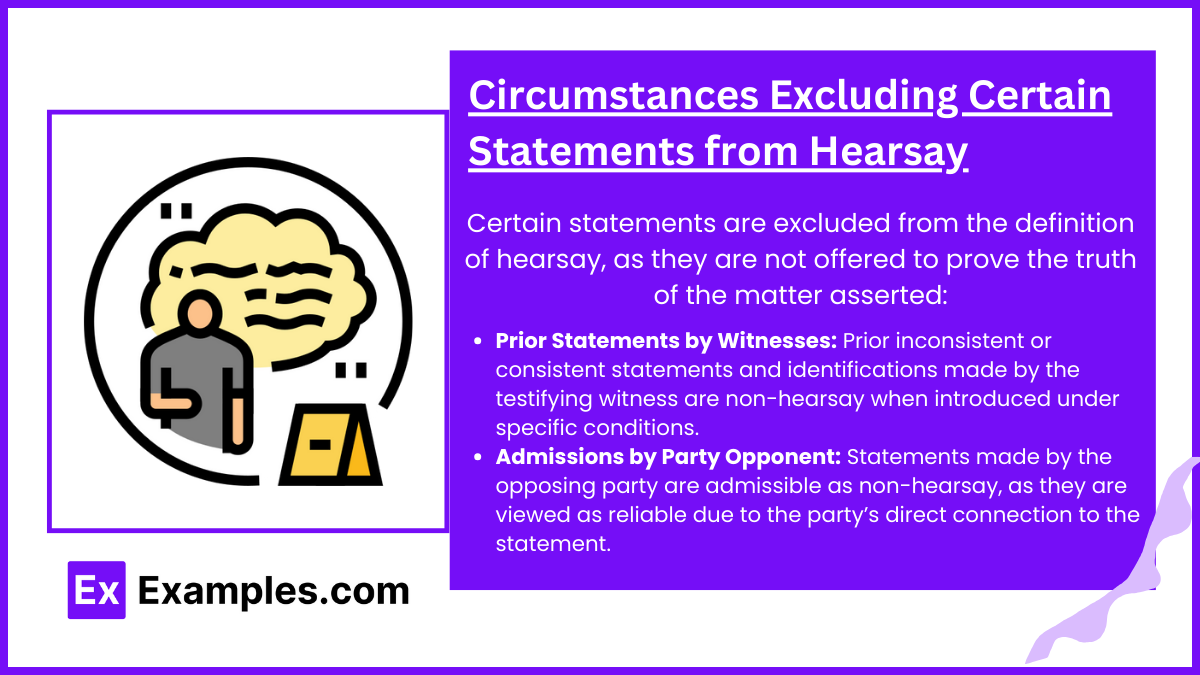
- Non-Hearsay by Definition
- Certain statements are excluded from the definition of hearsay, as they are not offered to prove the truth of the matter asserted:
- Prior Statements by Witnesses: Prior inconsistent or consistent statements and identifications made by the testifying witness are non-hearsay when introduced under specific conditions.
- Admissions by Party Opponent: Statements made by the opposing party are admissible as non-hearsay, as they are viewed as reliable due to the party’s direct connection to the statement.
- Certain statements are excluded from the definition of hearsay, as they are not offered to prove the truth of the matter asserted:
- Statements Offered for Another Purpose
- Statements not offered to prove their truth but for other purposes, such as showing the declarant’s state of mind or providing background context, are not considered hearsay.
Unavailability Requirement for Certain Exceptions

- Definition of Unavailability
- Unavailability occurs when a declarant cannot testify due to death, illness, absence, privilege, or refusal. Certain hearsay exceptions require the declarant to be unavailable.
- Examples of Exceptions Requiring Unavailability
- Former Testimony: Testimony given in previous proceedings is admissible if the declarant is unavailable and the opposing party had a prior opportunity to cross-examine.
- Dying Declaration: Statements made under the belief of impending death are admissible in homicide or civil cases, given the assumption of sincerity in the face of death.
- Statement Against Interest: The declarant’s unavailability is required when introducing a self-damaging statement that holds financial or penal implications.
Residual Exception
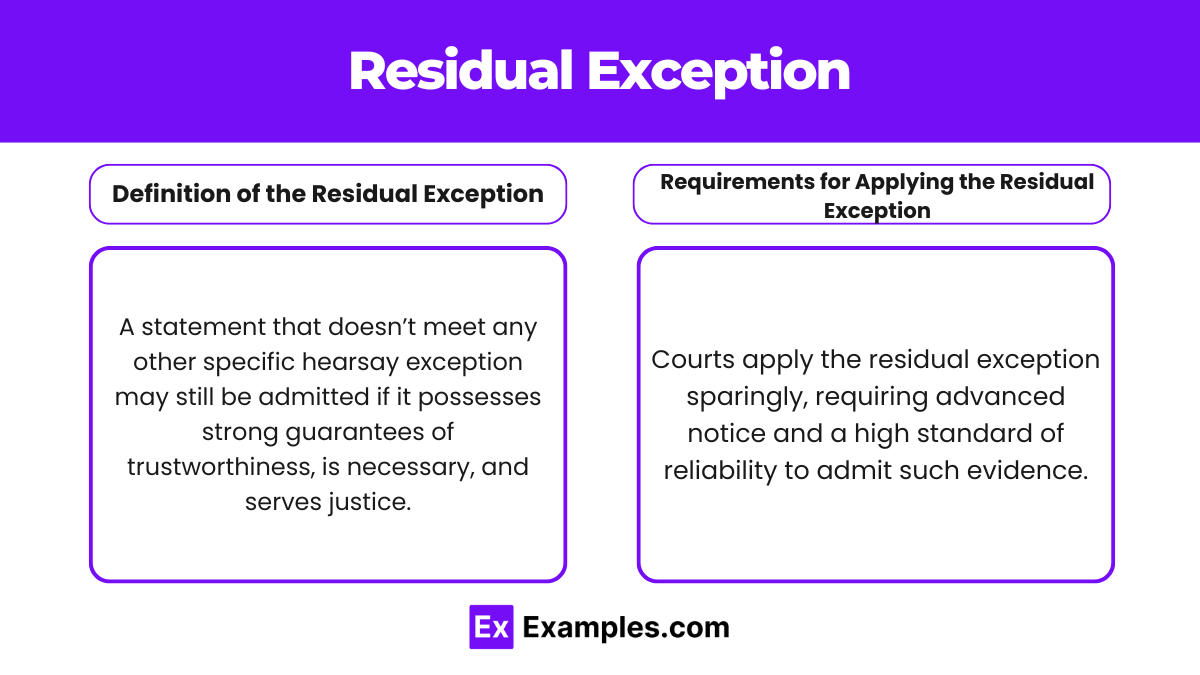
- Definition of the Residual Exception
- A statement that doesn’t meet any other specific hearsay exception may still be admitted if it possesses strong guarantees of trustworthiness, is necessary, and serves justice.
- Requirements for Applying the Residual Exception
- Courts apply the residual exception sparingly, requiring advanced notice and a high standard of reliability to admit such evidence.
Examples
Example 1
A witness recounts a statement made during a sudden event, “Watch out, he has a gun!” as an excited utterance, admissible due to the declarant’s stress.
Example 2
A dying individual’s statement, “It was John who shot me,” is introduced as a dying declaration in a homicide case, allowed due to the declarant’s belief of impending death.
Example 3
A statement in business records about a transaction made at the time is admissible due to the business records exception, ensuring reliability.
Example 4
A statement by a suspect during a police interrogation is excluded under the Confrontation Clause if the suspect cannot be cross-examined.
Example 5
A child’s statement describing symptoms to a doctor, made for medical treatment purposes, is admitted under the medical diagnosis exception.
Practice Questions
Question 1
During a trial, a witness describes what they heard during an accident, “The driver shouted, ‘I can’t stop!’” Which exception to the hearsay rule allows this statement?
(A) Business records
(B) Present sense impression
(C) Residual exception
(D) Statement against interest
Answer
(B) Present sense impression.
Explanation
A present sense impression is a statement made during or immediately after an event, describing it as it unfolds, making it reliable and admissible under this hearsay exception.
Question 2
A business owner records a customer complaint as part of the company’s standard procedure. Which hearsay exception allows this record’s admission?
(A) Excited utterance
(B) Business records exception
(C) Public records
(D) Prior statement by a witness
Answer
(B) Business records exception.
Explanation
The business records exception allows records made during the regular course of business to be admissible, assuming they were created accurately and in good faith.
Question 3
A declarant, believing they are dying, states who attacked them. This statement is admitted at trial. Which hearsay exception is applied here?
(A) Former testimony
(B) Statement against interest
(C) Dying declaration
(D) Present sense impression
Answer
(C) Dying declaration.
Explanation
A dying declaration, made under belief of impending death, is admissible in homicide and civil cases, as such statements are considered inherently reliable.

